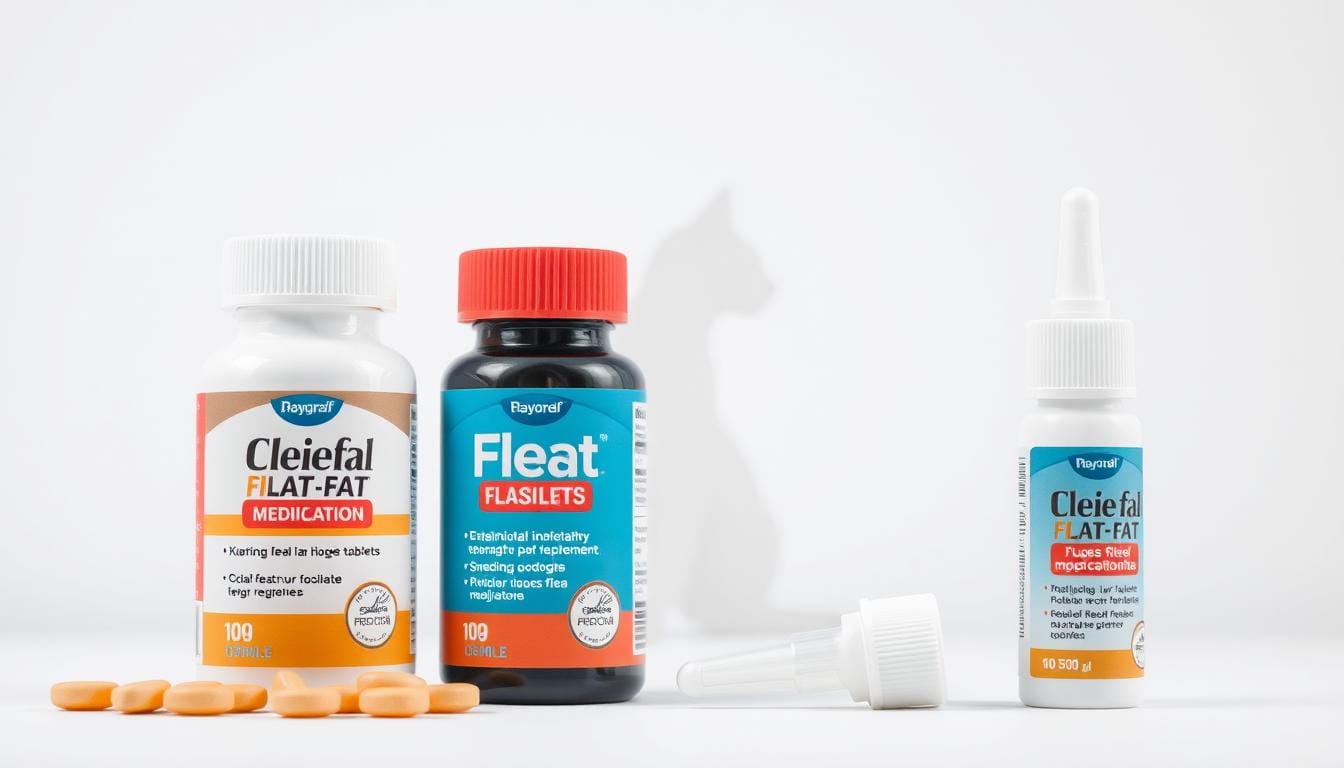
We’ve consulted with veterinarians, analyzed product effectiveness, and considered safety profiles to bring you the top 10 flea treatments for cats in 2024. Whether you’re dealing with an active infestation or looking for preventative care, we’ll help you find the perfect solution for your cat’s specific needs.
Oral Medications vs. Topical Treatments: A Comprehensive Comparison
Before diving into specific products, it’s important to understand the fundamental differences between the two main types of flea treatments: oral medications and topical applications. Each has distinct advantages and considerations that might make one more suitable for your cat’s situation.
| Feature | Oral Medications | Topical Treatments |
| Speed of Action | Typically begins working within 30 minutes to 2 hours | Usually takes 12-24 hours to reach full effectiveness |
| Duration of Protection | Usually 30 days per dose | 30 days to 8 months (collars) |
| Water Resistance | Not affected by bathing or swimming | Most are water-resistant after 24-48 hours |
| Administration Ease | Can be challenging with reluctant cats | Generally easier to apply but requires handling |
| Additional Protection | Some also treat intestinal parasites | Many also repel ticks and mosquitoes |
| Best For | Cats that are frequently bathed or dislike topical applications | Most household cats and those with sensitive stomachs |
Oral medications (left) vs. topical spot-on treatments (right) for feline flea control
Safety Considerations for Kittens and Senior Cats
Age-specific concerns are crucial when selecting the best flea treatment for cats in different life stages. Kittens and senior cats have unique physiological characteristics that affect how they process and respond to flea control products.
Kitten Safety (Under 8 Weeks)
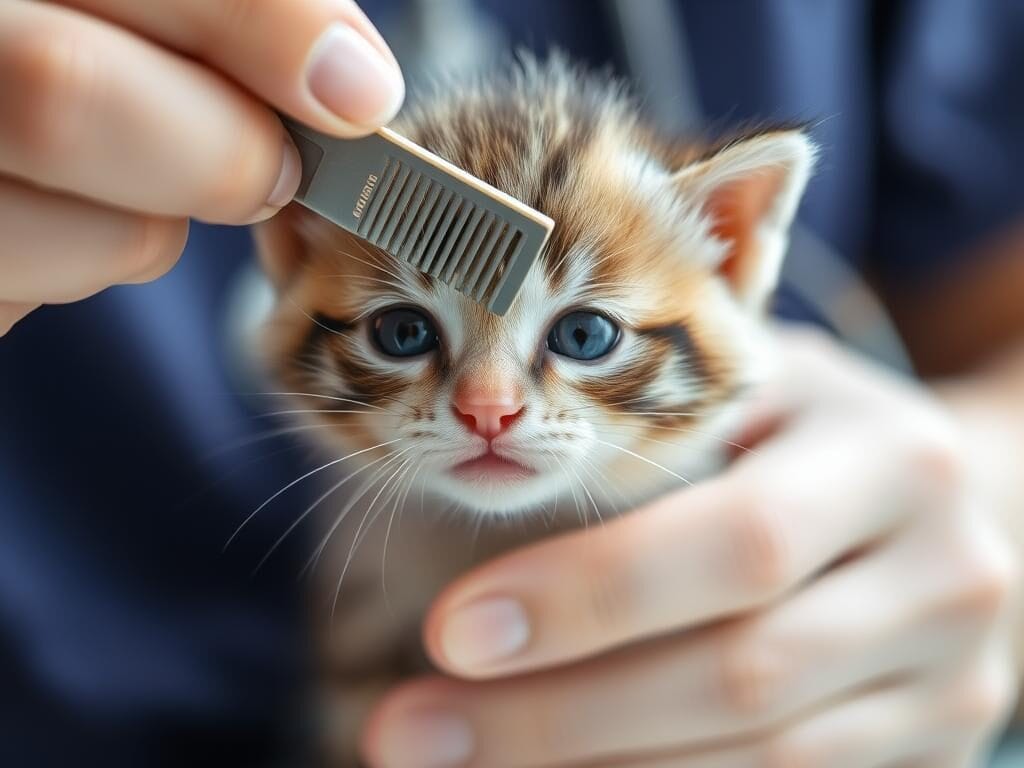
- Most commercial flea treatments are not approved for kittens under 8 weeks or weighing less than 1.5-2 pounds
- For very young kittens, use a flea comb with warm, soapy water to manually remove fleas
- Capstar is one of the few treatments safe for kittens as young as 4 weeks weighing at least 2 pounds
- Always check product labels for minimum age and weight requirements
- Avoid essential oils and permethrin-based products, which can be toxic to kittens
Need Help With a Young Kitten?
Flea infestations in very young kittens can be dangerous. Consult a veterinarian immediately for safe treatment options.
Senior Cat Considerations (10+ Years)
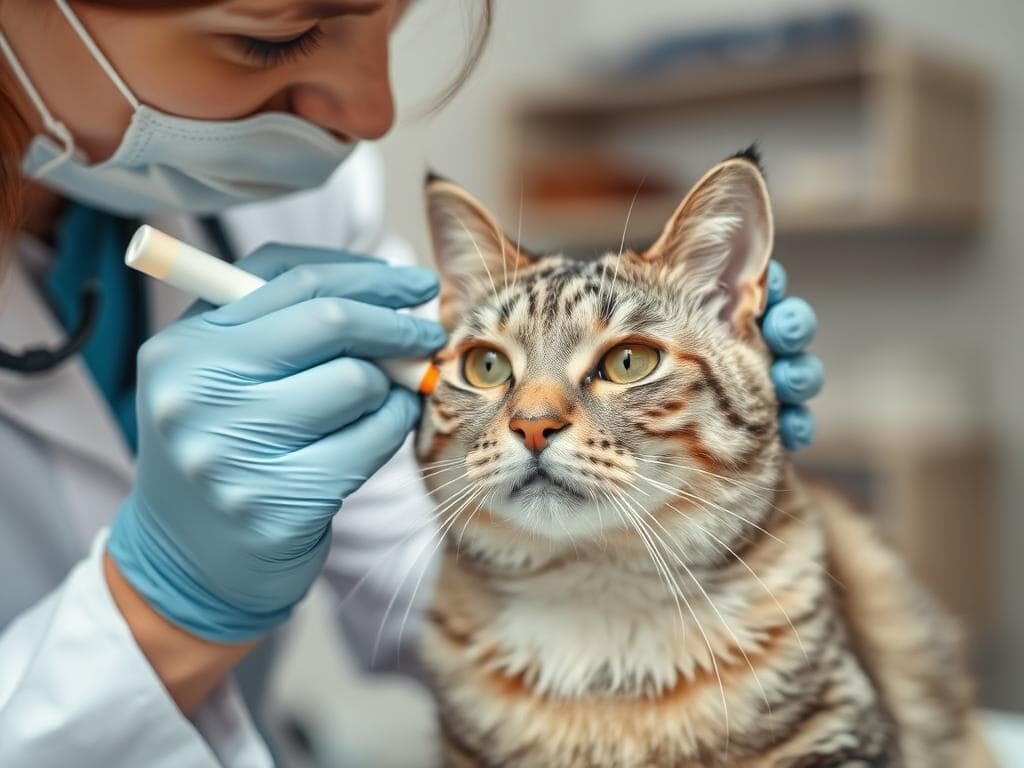
- Senior cats often have reduced kidney and liver function, affecting how they process medications
- Lower-dose options may be recommended by veterinarians
- Pre-treatment blood work is advisable to check organ function
- Monitor closely for side effects after application
- Cats with existing health conditions may need specially tailored flea control plans
Senior cats with kidney disease, hyperthyroidism, or other chronic conditions should only use flea treatments specifically approved by their veterinarian. Some ingredients may interact with medications or stress compromised organ systems.
Natural Remedies vs. Chemical Options: Pros and Cons
When choosing the best flea treatment for cats, many pet owners wonder about the effectiveness and safety of natural alternatives compared to conventional chemical treatments. Let’s examine both approaches objectively.
Natural Flea Remedies
Advantages
- Fewer synthetic chemicals and potentially gentler on sensitive cats
- May have fewer side effects when properly formulated
- Often more environmentally friendly
- Can be suitable for maintenance after treating a major infestation
- Some options like diatomaceous earth can help with environmental control
Disadvantages
- Generally less effective against severe infestations
- Require more frequent application
- Limited scientific evidence supporting efficacy
- Some “natural” ingredients like essential oils can be toxic to cats
- May not break the flea life cycle completely
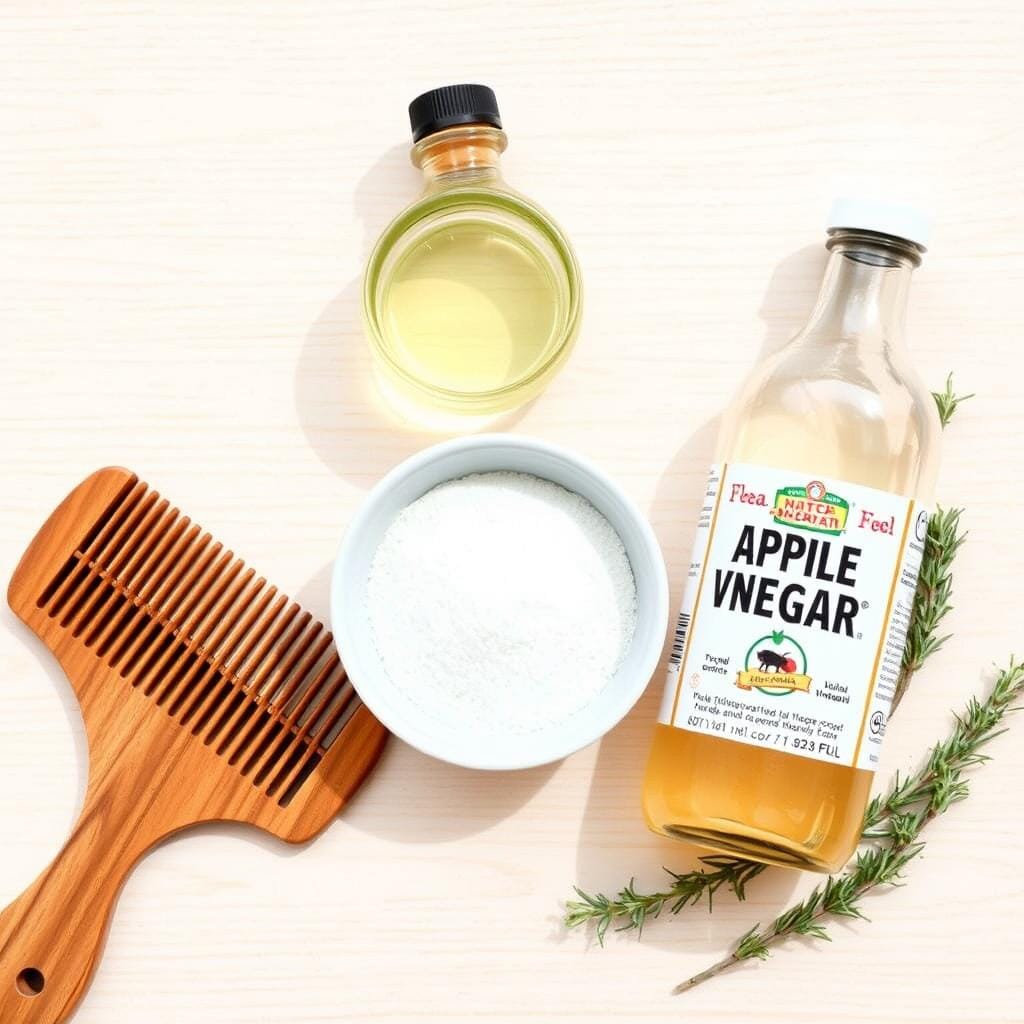
Chemical Flea Treatments
Advantages
- Highly effective at killing adult fleas, eggs, and larvae
- Longer-lasting protection (up to 30 days or more)
- Many also protect against ticks and other parasites
- Scientifically tested and FDA/EPA regulated
- Can quickly control severe infestations
Disadvantages
- Potential for side effects in some cats
- Some cats may be sensitive to certain active ingredients
- Higher concentration of synthetic chemicals
- Some products require veterinary prescription
- Environmental concerns with certain ingredients

Veterinarian’s Perspective
“While natural remedies can be helpful supplementary treatments, severe flea infestations typically require the proven efficacy of veterinary-approved chemical treatments to break the flea life cycle completely. The best approach is often an integrated one that combines appropriate medical treatments with environmental management.”
5 Key Factors to Consider When Buying Flea Treatment for Cats
Selecting the best flea treatment for your cat requires careful consideration of several important factors. Here are the five most critical elements to evaluate before making your purchase:

1. Speed of Action
How quickly the treatment begins killing fleas is crucial, especially if your cat is suffering from an active infestation. Some products start working within 30 minutes, while others may take 12-24 hours to reach full effectiveness.
What to look for: Products containing nitenpyram provide the fastest relief, killing adult fleas within 30 minutes. Isoxazoline-class medications (like fluralaner) also act relatively quickly, usually within a few hours.
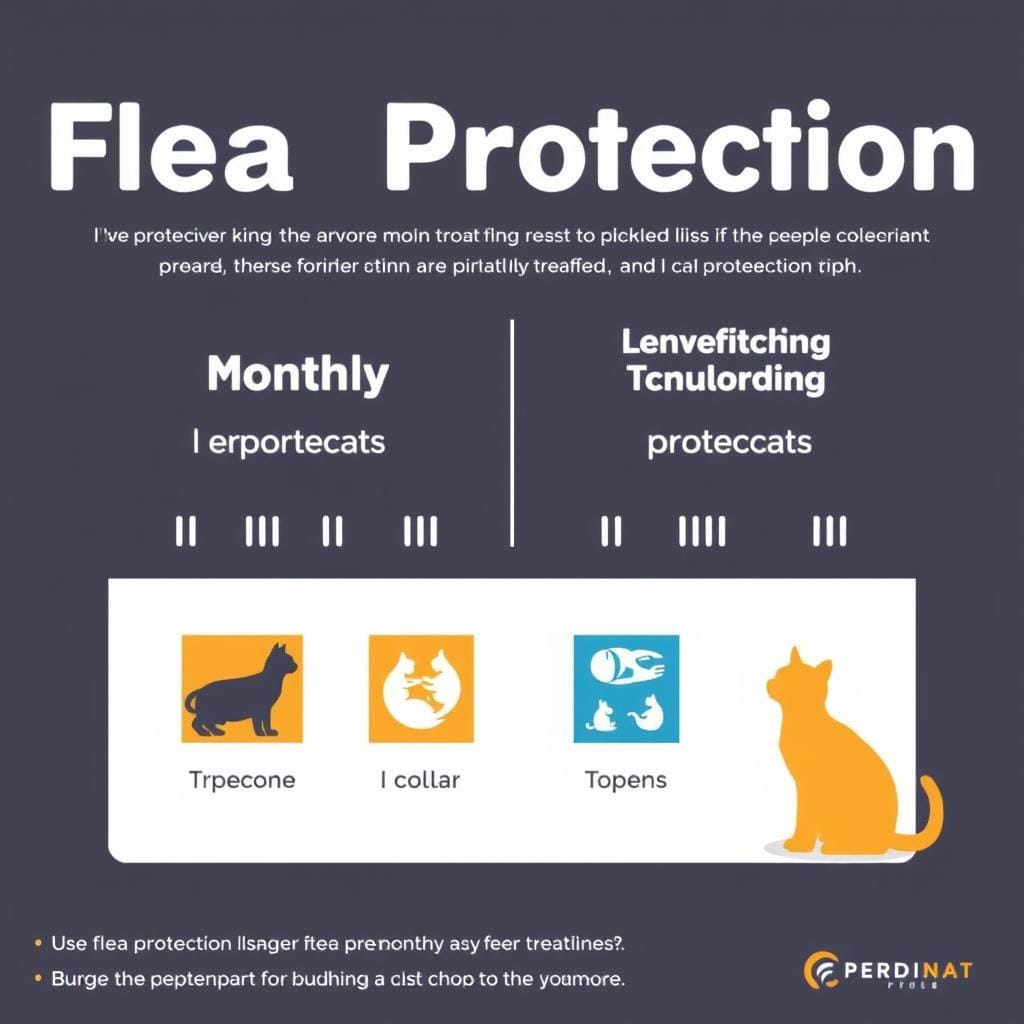
2. Duration of Protection
Treatment frequency affects both convenience and cost. Monthly applications are standard, but some newer products offer extended protection periods.
What to look for: Monthly spot-on treatments and oral medications provide 30-day protection. Bravecto offers 12-week protection, while flea collars like Seresto can last up to 8 months.

3. Spectrum of Control
Many modern flea treatments protect against multiple parasites, offering better value and comprehensive protection for your cat.
What to look for: Products like Revolution Plus and Bravecto Plus not only kill fleas but also protect against ticks, ear mites, and some internal parasites like heartworm and intestinal worms.
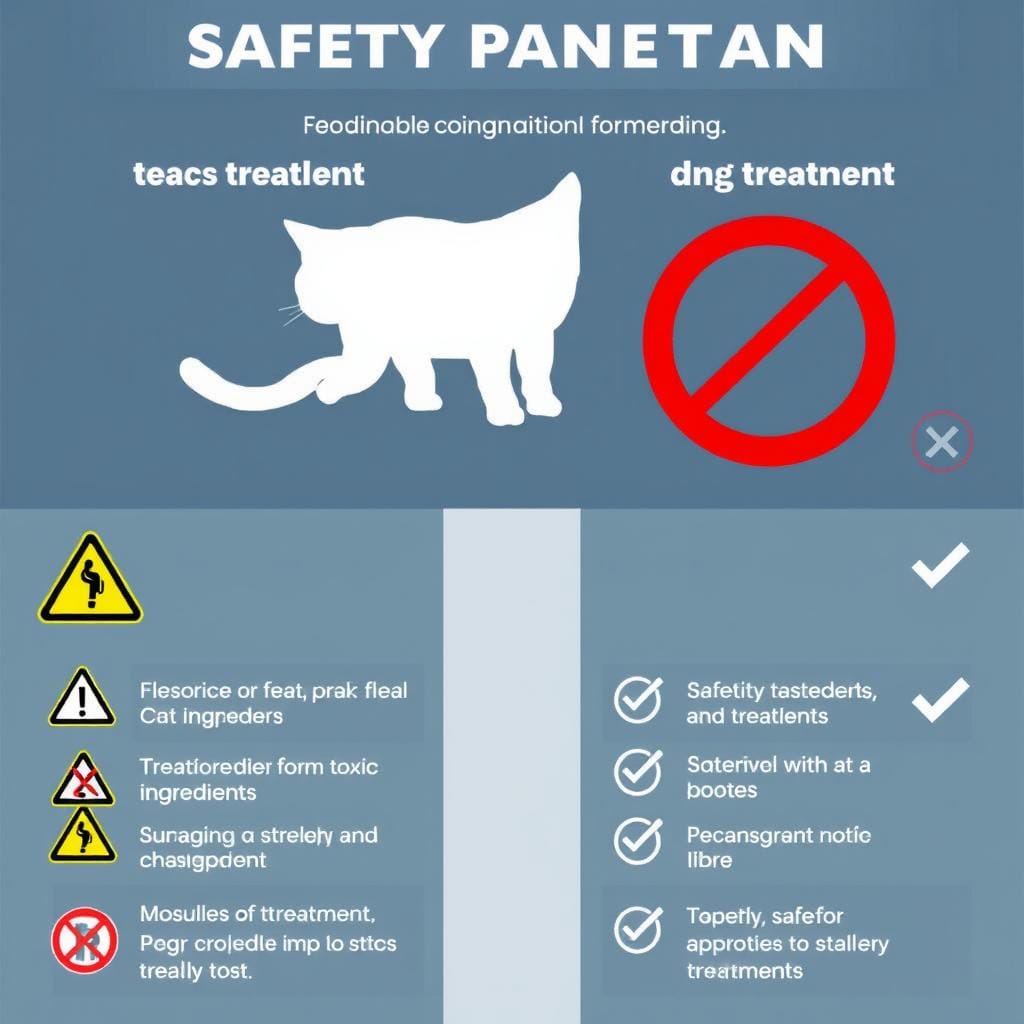
4. Safety Profile
The safety of any treatment should be a top priority, especially for kittens, senior cats, or those with health conditions.
What to look for: FDA or EPA approval, age-appropriate formulations, and products specifically designed for cats. Never use dog flea treatments on cats, as ingredients like permethrin can be fatal to felines.
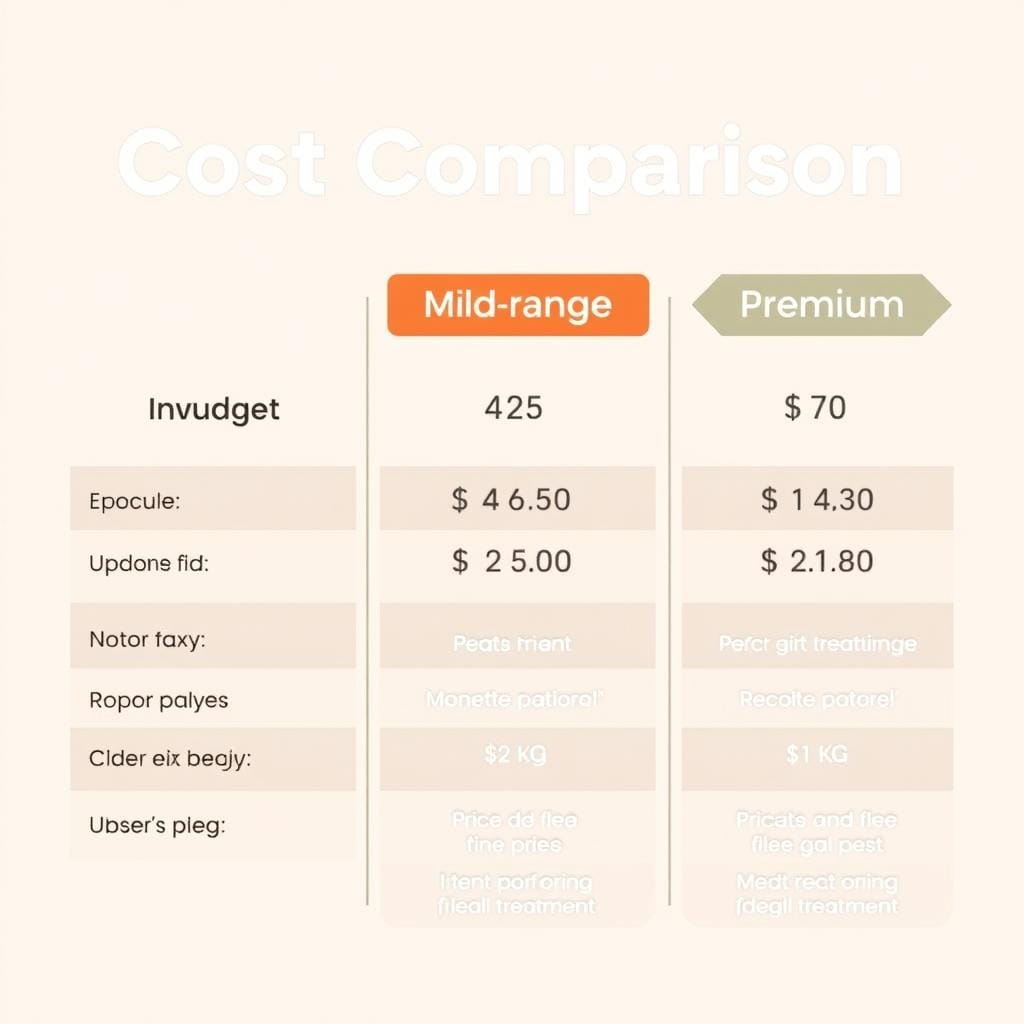
5. Cost Effectiveness
Price varies significantly between products, but the cheapest option isn’t always the most economical in the long run.
What to look for: Consider the cost per month of protection rather than just the sticker price. A more expensive product that lasts longer or treats multiple parasites may offer better value than cheaper alternatives that need frequent replacement.
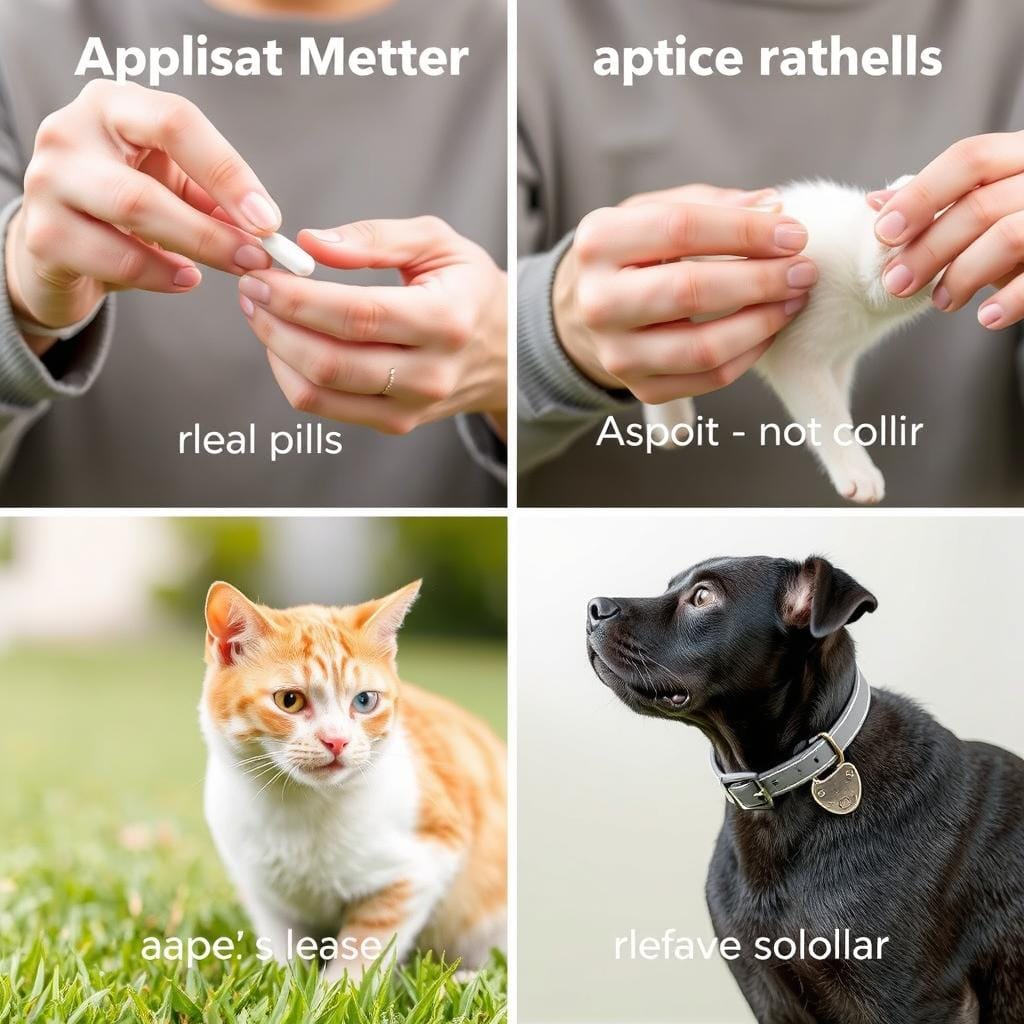
Bonus: Ease of Application
The most effective treatment is the one you can actually administer successfully to your cat.
What to look for: Consider your cat’s temperament and your comfort level. Spot-on treatments are generally easier to apply than oral medications for most cats, while collars offer the simplest application but may not be tolerated by all cats.
Not Sure Which Factor Matters Most for Your Cat?
Every cat’s situation is unique. Consult with your veterinarian to determine which aspects should be prioritized based on your cat’s age, health status, and lifestyle.
The 10 Best Flea Treatments for Cats in 2024
After extensive research and veterinary consultation, we’ve identified the top 10 most effective flea treatments for cats currently available. Each product has been evaluated based on efficacy, safety profile, ease of use, and value for money.
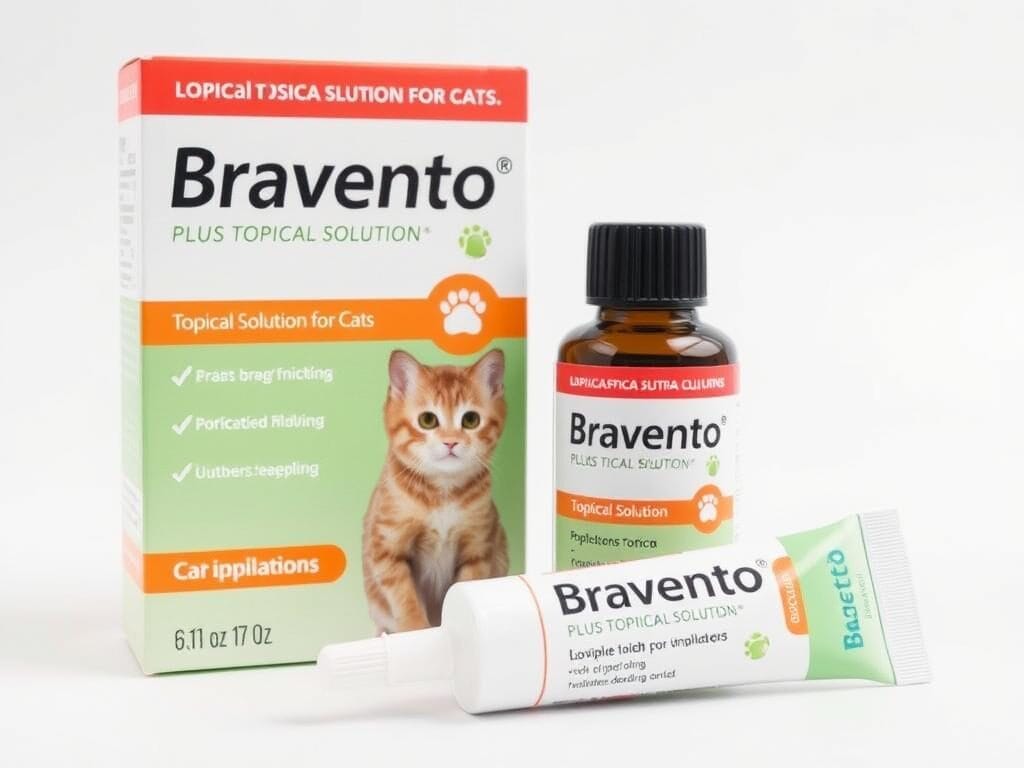
1. Bravecto Plus Topical Solution
Type: Topical solution
Duration: 2 months per application
Minimum Age: 6 months
Key Benefits: Extended 2-month protection, kills fleas and ticks, prevents heartworm, and treats hookworm and roundworm infections. Helps control home flea infestations within 8 weeks.
Considerations: Cannot be used on kittens younger than 6 months. Higher upfront cost, though economical over time due to less frequent application.
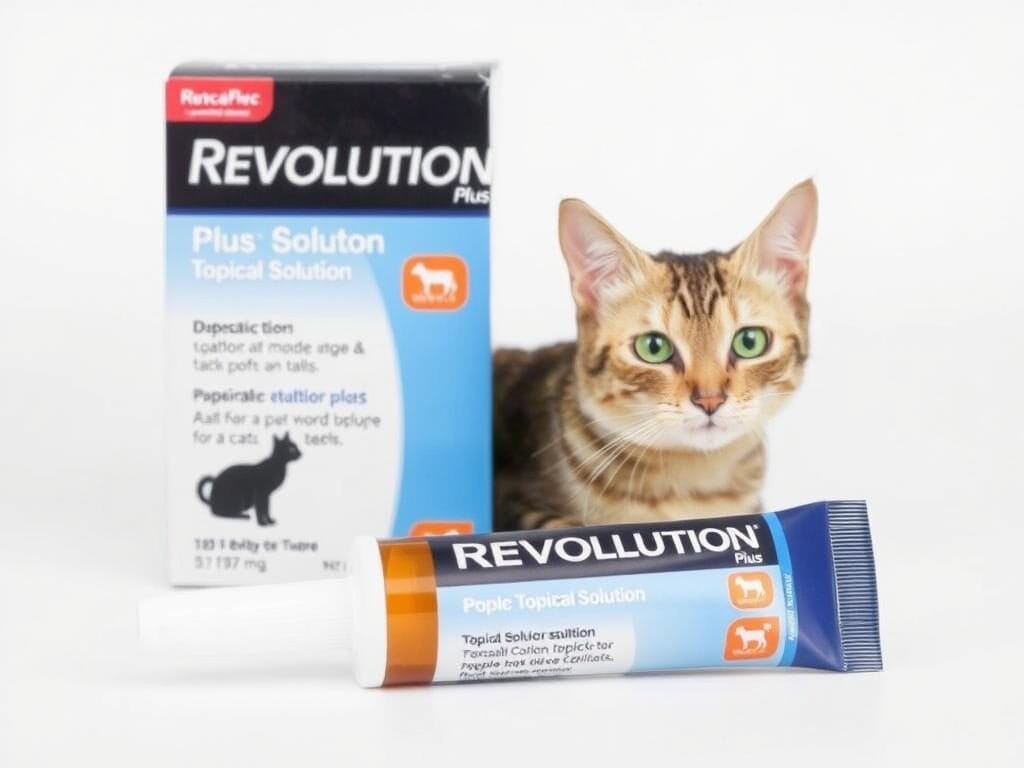
2. Revolution Plus
Type: Topical solution
Duration: 1 month per application
Minimum Age: 8 weeks
Key Benefits: Broad spectrum protection against fleas, ticks, ear mites, heartworm, and intestinal parasites. Can be used on younger kittens (8 weeks+) compared to Bravecto Plus.
Considerations: Requires monthly application. Some cats may experience temporary application site reactions.
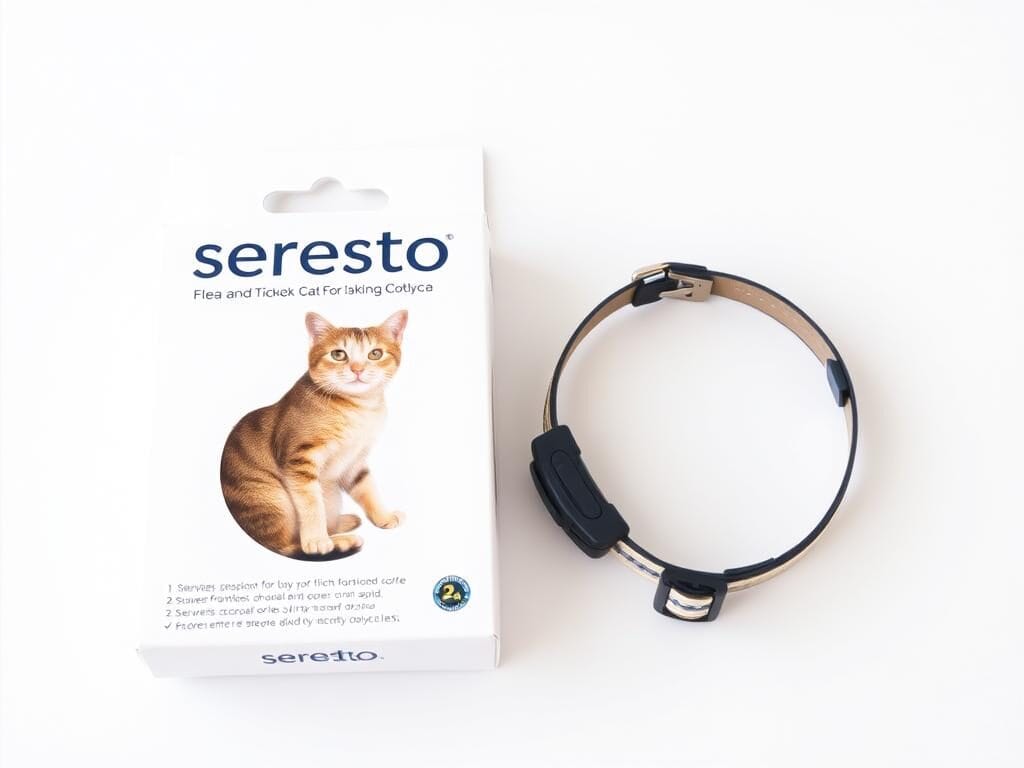
3. Seresto Flea and Tick Collar
Type: Collar
Duration: 8 months
Minimum Age: 10 weeks
Key Benefits: Longest-lasting protection (8 months) of any treatment. Both repels and kills fleas and ticks. No prescription required. Water-resistant design.
Considerations: Does not protect against internal parasites. Some cats may not tolerate wearing a collar. Recent safety concerns have been addressed by manufacturer with improved release mechanism.
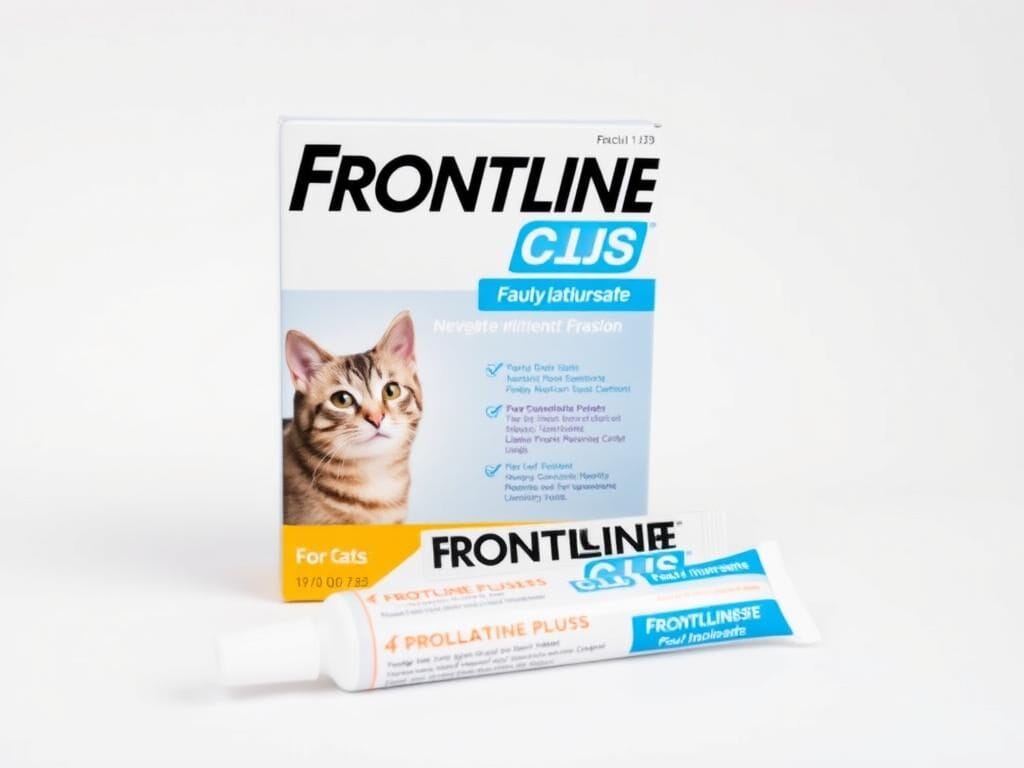
4. Frontline Plus
Type: Topical solution
Duration: 1 month per application
Minimum Age: 8 weeks
Key Benefits: Widely available without prescription. Kills adult fleas, eggs, and larvae. Also effective against ticks and chewing lice. Long track record of safety since the 1990s.
Considerations: Does not protect against internal parasites. Some reports of decreasing effectiveness in certain regions due to flea resistance.
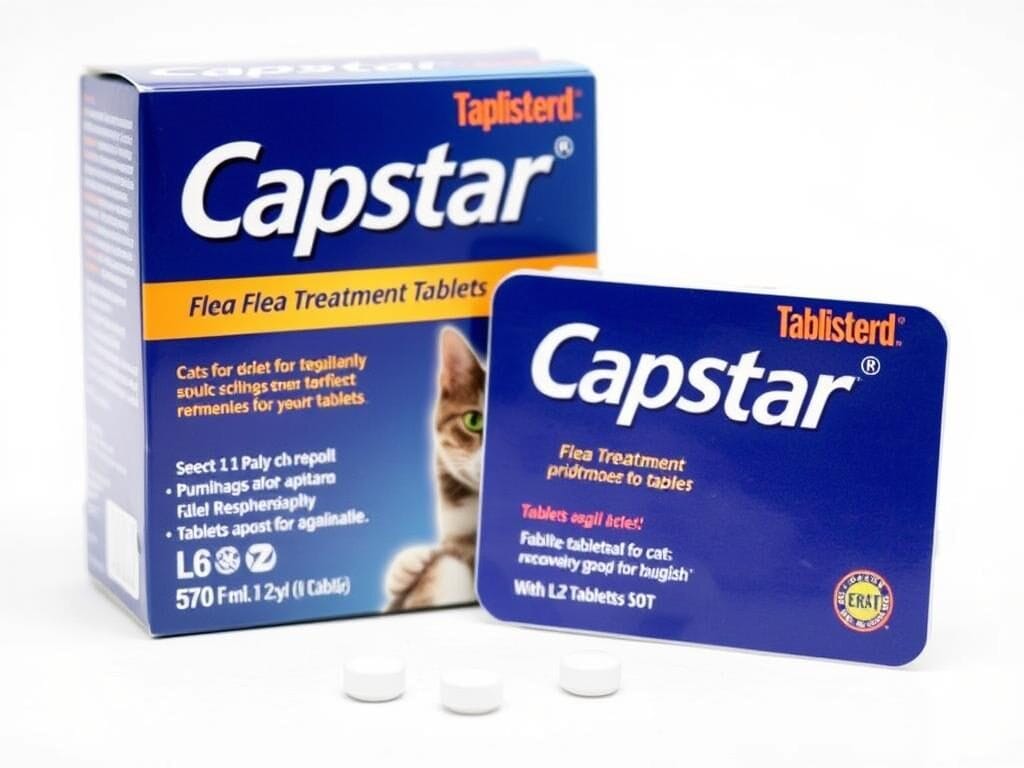
5. Capstar
Type: Oral tablet
Duration: 24 hours
Minimum Age: 4 weeks (if at least 2 pounds)
Key Benefits: Fastest-acting treatment available, killing adult fleas within 30 minutes. Safe for very young kittens (4+ weeks). No prescription required. Can be used alongside other treatments.
Considerations: Very short duration (24 hours only). Does not kill eggs or prevent future infestations. Best used as immediate relief while starting a longer-term treatment.

6. Advantage II
Type: Topical solution
Duration: 1 month per application
Minimum Age: 8 weeks (if at least 2 pounds)
Key Benefits: Fast-acting, killing all adult fleas within 12 hours of application. No prescription required. Disrupts flea life cycle by preventing egg development.
Considerations: Does not protect against ticks or internal parasites. Some cats may experience skin irritation at the application site.
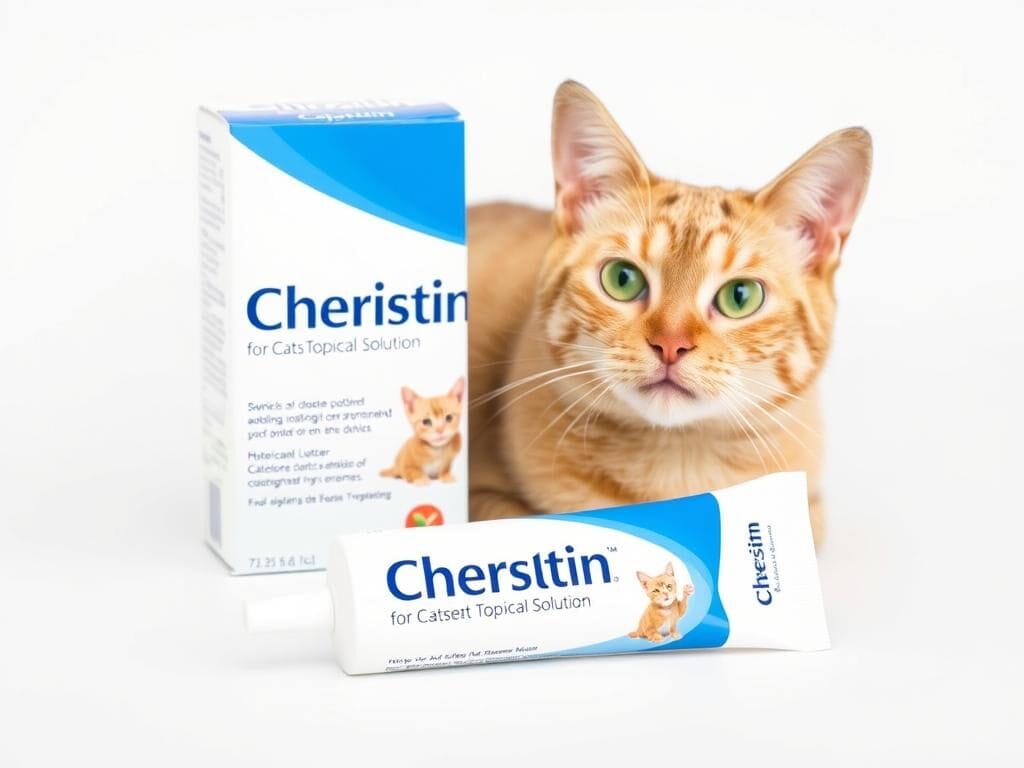
7. Cheristin for Cats
Type: Topical solution
Duration: 1 month per application
Minimum Age: 8 weeks
Key Benefits: Starts killing fleas within 30 minutes. No prescription required. Specifically formulated for cats with a lower concentration of active ingredients to reduce side effects.
Considerations: Only treats fleas, not ticks or other parasites. Some cats may experience temporary hair loss at the application site.

8. Comfortis
Type: Oral tablet
Duration: 1 month per dose
Minimum Age: 14 weeks (if at least 4 pounds)
Key Benefits: Begins killing adult fleas within 30 minutes. Good option for cats that swim or are bathed frequently. Not affected by water exposure.
Considerations: Prescription required. Some cats may experience digestive upset. Does not protect against ticks or other parasites. Can be difficult to administer to cats that resist taking pills.
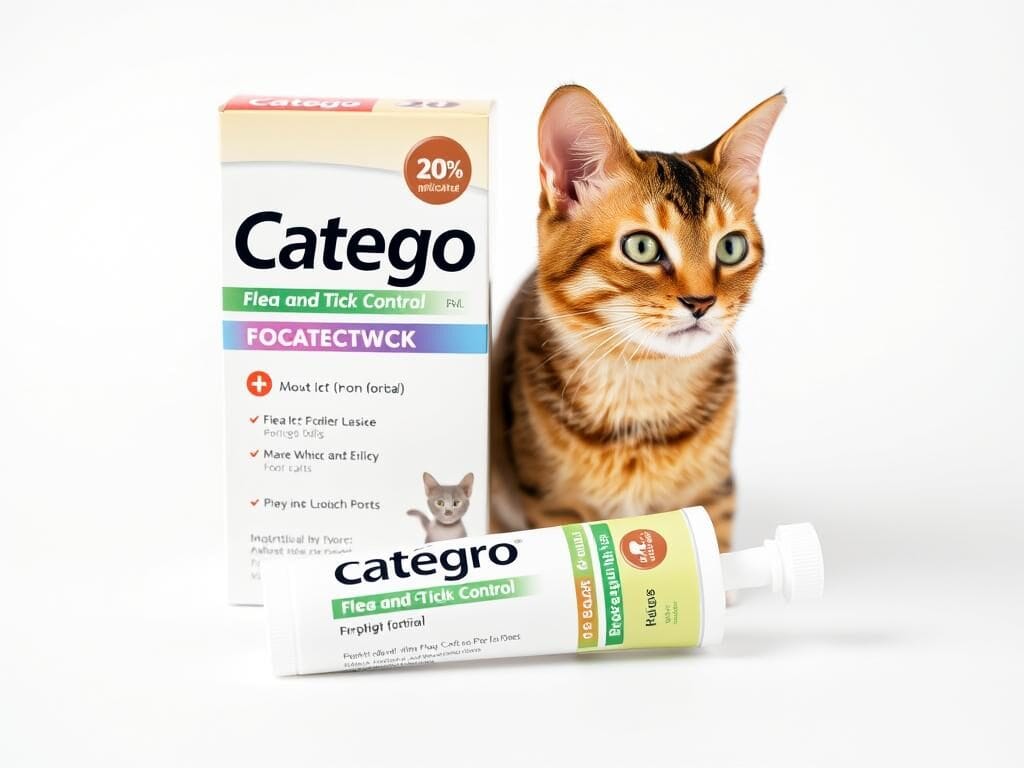
9. Catego
Type: Topical solution
Duration: 1 month per application
Minimum Age: 8 weeks
Key Benefits: Fast-acting formula that kills fleas, ticks, and lice. No prescription required. Uses a combination of three active ingredients for enhanced effectiveness.
Considerations: Does not protect against internal parasites. Relatively new product with less long-term safety data compared to established brands.
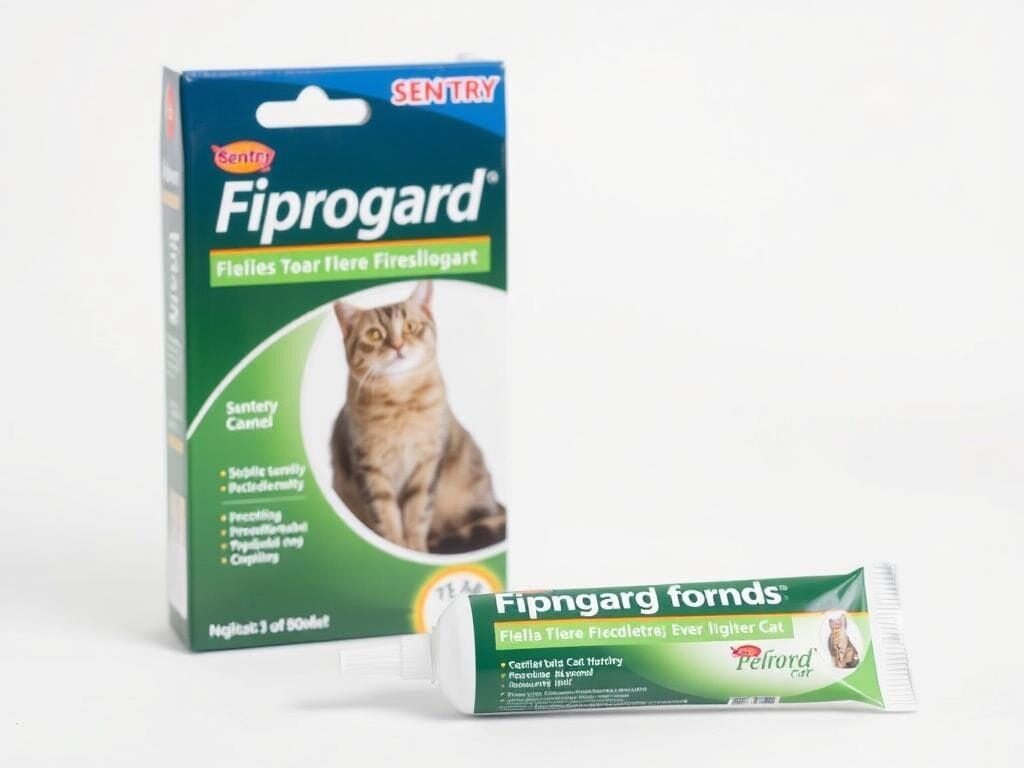
10. Sentry Fiproguard
Type: Topical solution
Duration: 1 month per application
Minimum Age: 8 weeks
Key Benefits: Budget-friendly alternative to Frontline using the same active ingredient (fipronil). No prescription required. Effective against fleas, ticks, and chewing lice.
Considerations: May not be as consistently effective as premium brands. Does not protect against internal parasites. Some cats may experience skin irritation at the application site.
Find the Right Flea Treatment for Your Cat
Not sure which option is best for your cat’s specific needs? Consult with a veterinarian to get personalized recommendations based on your cat’s age, health status, and lifestyle.
Debunking Common Flea Treatment Myths
There’s a lot of misinformation about flea treatments for cats. Let’s separate fact from fiction to help you make better decisions about your cat’s flea control regimen.
Myth #1: Indoor Cats Don’t Need Flea Prevention
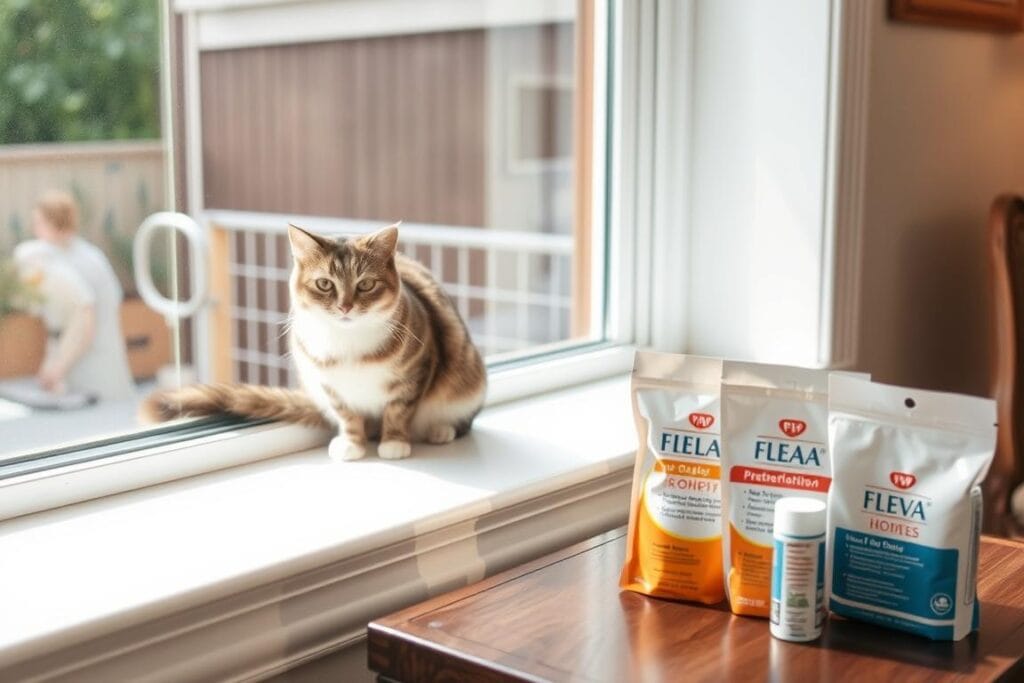
The Truth: Even strictly indoor cats can get fleas. Fleas can hitch a ride on your clothing, enter through screens, or come in with other pets. Once inside, they can quickly establish an infestation that’s difficult to eliminate.
All cats, regardless of lifestyle, should receive regular flea prevention to avoid the health risks and discomfort associated with flea infestations.
Myth #2: Natural Remedies Are Just as Effective as Veterinary Products
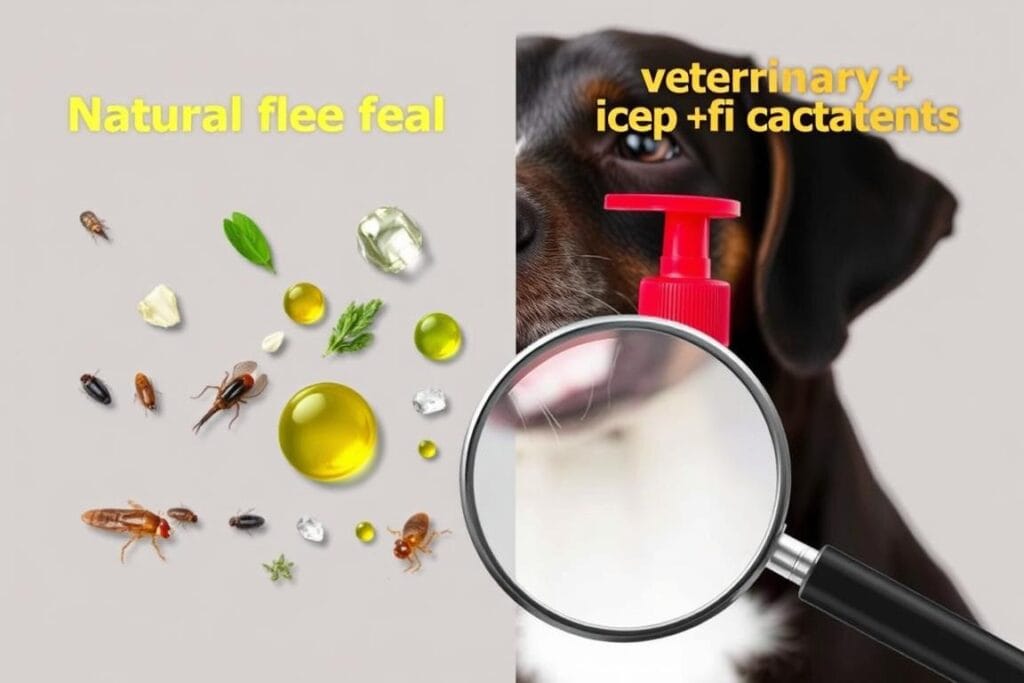
The Truth: While some natural ingredients have mild repellent properties, they typically don’t match the efficacy of veterinary-approved products for eliminating existing infestations or providing long-term protection.
Most natural remedies haven’t undergone rigorous testing for safety and efficacy, and some “natural” ingredients like essential oils can actually be toxic to cats due to their inability to metabolize certain compounds.
Myth #3: Flea Treatments Are Only Needed in Summer

The Truth: Fleas can survive and thrive year-round, especially in heated homes. While outdoor flea populations may decrease in colder months in some regions, indoor environments provide ideal conditions for fleas to continue their life cycle regardless of season.
Consistent, year-round prevention is the most effective approach to flea control, preventing gaps in protection that can lead to infestations.
Myth #4: One Treatment Will Solve a Flea Problem
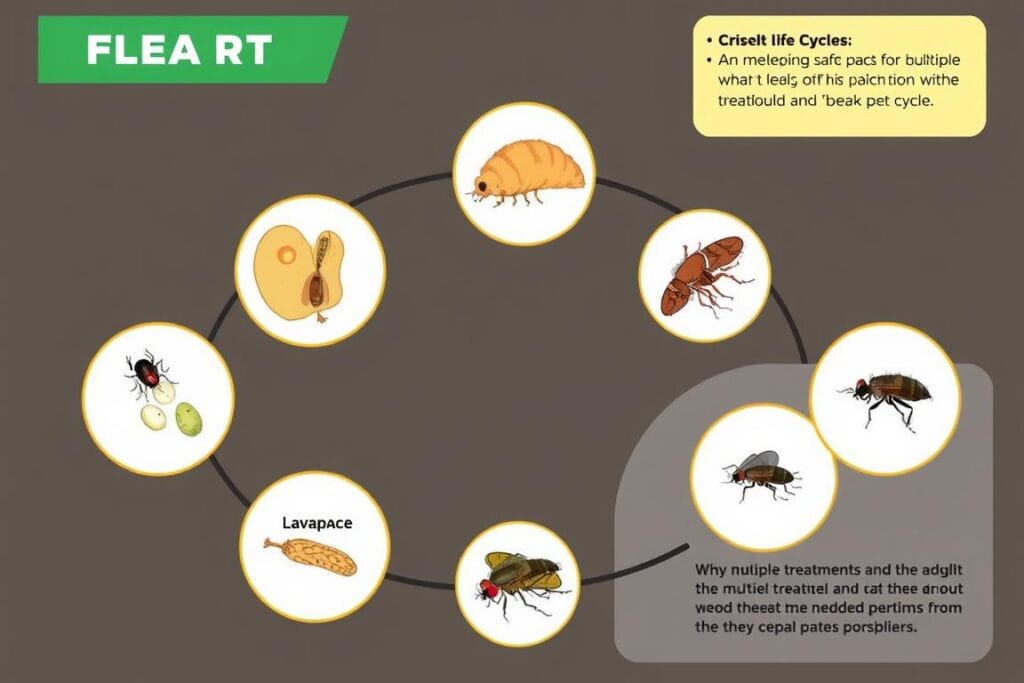
The Truth: Flea control requires addressing all stages of the flea life cycle. Adult fleas visible on your cat represent only about 5% of the total flea population in your home. The remaining 95% exists as eggs, larvae, and pupae in your environment.
Effective flea control requires consistent treatment for at least 3-4 months to break the life cycle completely, along with environmental management like vacuuming and washing bedding.
Myth #5: All Flea Products Are Basically the Same

The Truth: Flea products vary significantly in their active ingredients, mechanisms of action, spectrum of parasites covered, and safety profiles. Some kill only adult fleas, while others affect multiple life stages. Some repel parasites, while others require the parasite to bite to be effective.
Different active ingredients also target different parasites beyond fleas, such as ticks, mites, or internal parasites. Choosing the right product should be based on your cat’s specific needs and risk factors.
Myth #6: Dog Flea Products Can Be Used on Cats

The Truth: This is an extremely dangerous myth. Many dog flea products contain permethrin, which is highly toxic to cats and can cause severe neurological symptoms or death, even in small amounts.
Cats lack certain liver enzymes needed to metabolize many chemicals, making them much more sensitive to certain ingredients that dogs can tolerate. Always use products specifically labeled for cats, and keep dog treatments away from your feline friends.
Emergency Vet Tips for Flea Allergy Dermatitis
Flea Allergy Dermatitis (FAD) is one of the most common skin conditions in cats. It occurs when cats develop an allergic reaction to flea saliva, causing intense itching and discomfort even from a single flea bite. Here are three emergency veterinary tips for managing acute FAD episodes:
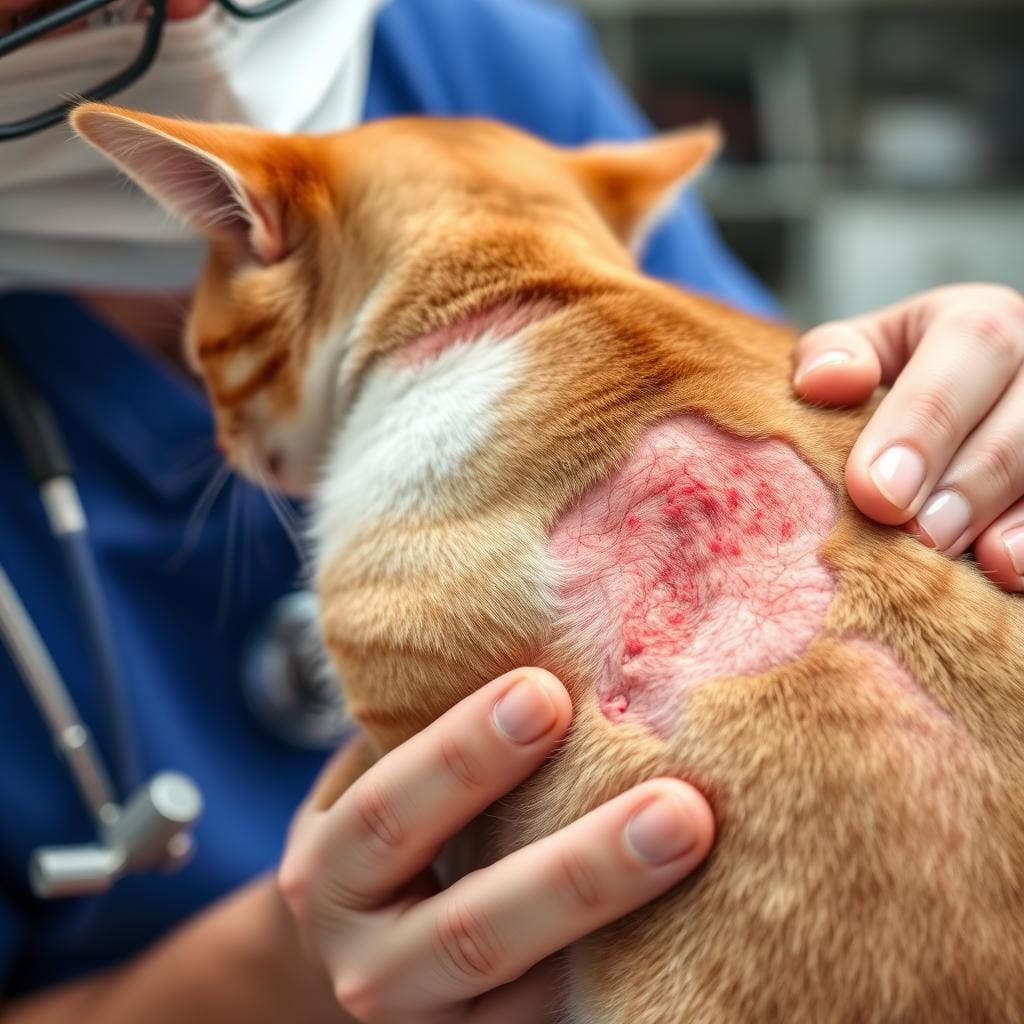
1. Immediate Flea Elimination
Emergency Action: Administer a fast-acting flea treatment like Capstar (nitenpyram) to kill adult fleas within 30 minutes. This provides immediate relief while longer-term treatments take effect.
Veterinarian’s Note: “In severe FAD cases, eliminating fleas quickly is critical. A single flea bite can trigger days of allergic reaction. I recommend keeping a supply of fast-acting flea treatment on hand if your cat has known flea allergies.”
Never use multiple flea treatments simultaneously without veterinary guidance, as this can lead to toxicity. Call your vet before combining products.
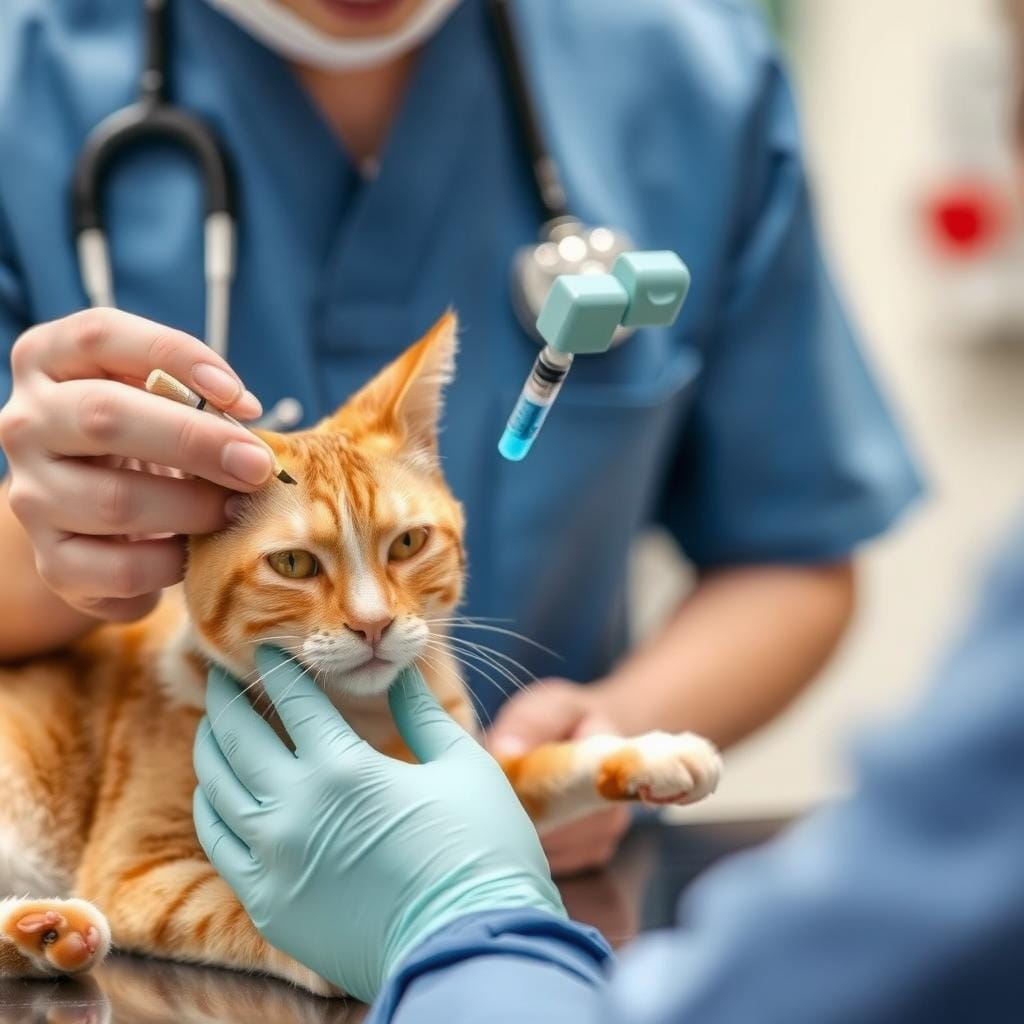
2. Anti-Inflammatory Treatment
Emergency Action: For severe itching and inflammation, your veterinarian may administer a corticosteroid injection or prescribe oral anti-inflammatory medication to provide rapid relief from allergic symptoms.
Veterinarian’s Note: “While we try to avoid long-term steroid use, a short course can be appropriate for breaking the itch-scratch cycle in acute FAD flare-ups. This gives the skin a chance to heal while flea control measures take effect.”
Cool compresses with a damp cloth can provide temporary relief while waiting for veterinary care. Apply gently to affected areas for 5-10 minutes.
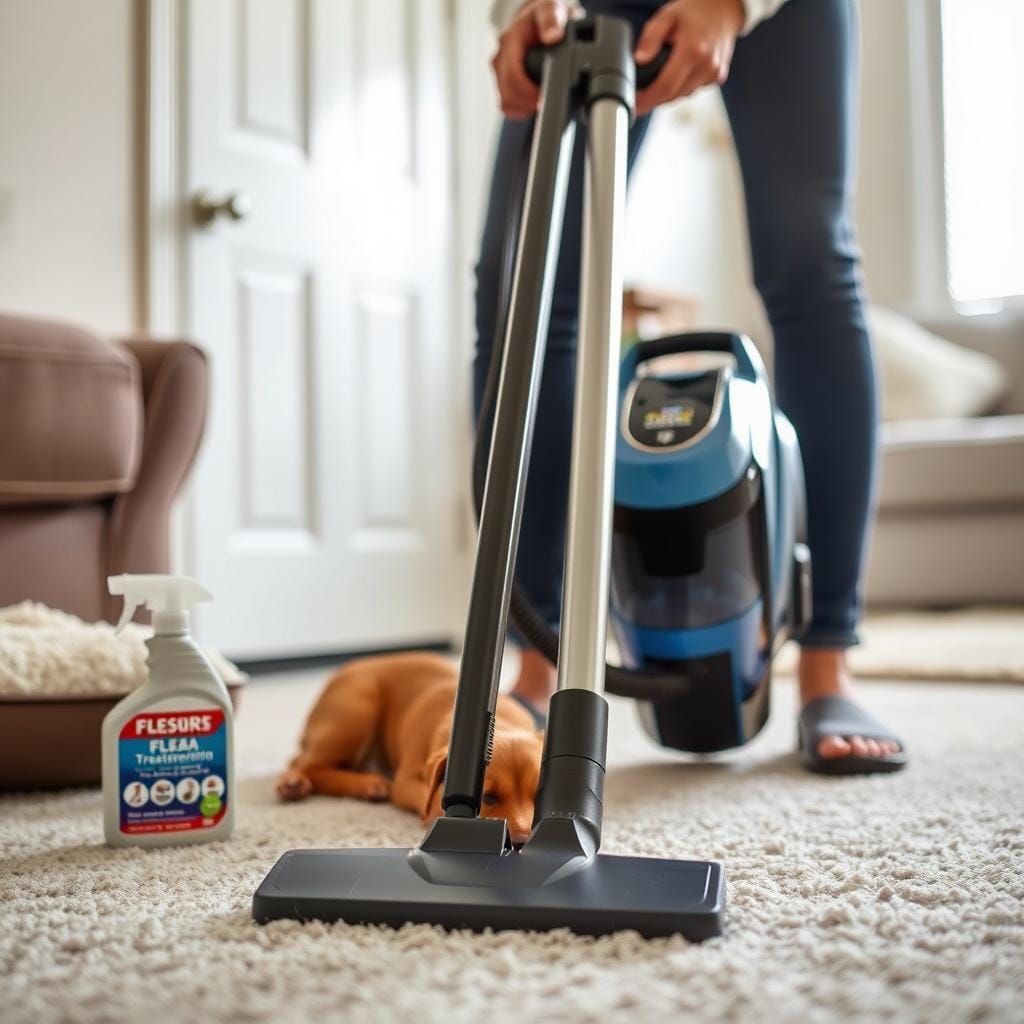
3. Environmental Treatment
Emergency Action: Treat your home environment immediately with appropriate flea control products. Vacuum thoroughly (especially under furniture and along baseboards), wash all bedding in hot water, and consider using environmental flea treatments like sprays or foggers for severe infestations.
Veterinarian’s Note: “Environmental control is essential for FAD management. Even with excellent on-animal flea control, environmental fleas can continue to bite and trigger allergic reactions. A multi-pronged approach is necessary.”
For severe home infestations, professional pest control services specializing in flea treatment may be necessary to completely eliminate the problem.
Is Your Cat Suffering from Flea Allergy Dermatitis?
If your cat is showing signs of intense itching, hair loss, scabs, or skin inflammation, don’t wait – flea allergy dermatitis requires prompt veterinary attention to prevent self-trauma and secondary infections.
Frequently Asked Questions About Flea Treatments for Cats
Are flea collars safe for cats?
Modern flea collars like Seresto are generally safe for most cats when used as directed. However, safety concerns have been raised about some collar brands, so it’s important to:
- Choose collars specifically designed for cats (never use dog collars)
- Ensure the collar has a quick-release mechanism in case your cat gets caught
- Monitor for any signs of irritation around the neck
- Remove the collar immediately if you notice adverse reactions
- Consider your cat’s lifestyle and temperament (some cats don’t tolerate collars well)
Flea collars are most appropriate for cats that tolerate wearing collars and don’t have a history of skin sensitivity. If you’re concerned, topical or oral treatments may be safer alternatives.
Can dog flea medications harm cats?
Yes, dog flea medications can be extremely dangerous or fatal to cats. Many dog flea products contain permethrin, an insecticide that cats cannot metabolize properly due to a deficiency in specific liver enzymes.
Even small exposures to permethrin can cause severe neurological symptoms in cats, including:
- Tremors and muscle twitching
- Seizures
- Hyperthermia (elevated body temperature)
- Drooling
- Vomiting
- Difficulty walking
- Death (in severe cases)
Never use any flea product on your cat unless it explicitly states it is safe for cats on the label. Keep dog flea treatments stored separately and ensure treated dogs don’t come in contact with cats until the product has dried completely.
If you suspect your cat has been exposed to a dog flea product, this is a medical emergency. Wash the area with mild dish soap if topically applied, and seek immediate veterinary care.
How often should I treat my cat for fleas?
Treatment frequency depends on the specific product you’re using:
- Monthly treatments: Most topical spot-on treatments and oral medications require monthly application
- Bi-monthly treatments: Bravecto Plus lasts for 2 months
- Long-lasting options: Seresto collar provides up to 8 months of protection
For optimal protection, maintain a consistent treatment schedule year-round, even during winter months. Set calendar reminders to ensure you don’t miss applications. Gaps in treatment can allow flea populations to reestablish quickly.
What should I do if my cat has a reaction to flea treatment?
If you notice any adverse reactions after applying flea treatment, take these steps:
- For topical treatments: Bathe your cat with mild dish soap (like Dawn) and lukewarm water to remove as much product as possible
- Monitor for worsening symptoms including excessive drooling, vomiting, tremors, or lethargy
- Contact your veterinarian or an emergency animal hospital immediately
- Bring the product packaging with you to the vet so they know exactly what active ingredients were used
Mild reactions like temporary application site irritation are common and usually resolve within 24 hours. However, more severe reactions require immediate veterinary attention.
Can I use flea treatments on pregnant or nursing cats?
Many flea treatments are not tested or approved for use on pregnant or nursing cats. Always consult your veterinarian before using any flea control product on a pregnant or nursing cat.
Some general guidelines:
- Fipronil-based products (like Frontline) are generally considered safer options when treatment is necessary
- Avoid isoxazoline class medications during pregnancy and nursing unless specifically directed by your veterinarian
- Manual flea removal with a flea comb is the safest approach but may not be sufficient for controlling infestations
Your veterinarian can recommend the safest and most appropriate flea control strategy based on your cat’s specific situation and the severity of the flea problem.
Conclusion: Finding the Best Flea Treatment for Your Cat
Choosing the best flea treatment for cats requires balancing effectiveness, safety, convenience, and your cat’s specific needs. The most expensive option isn’t always necessary, nor is the cheapest option always sufficient. The “best” treatment is one that effectively protects your cat while fitting your lifestyle and budget.
Remember these key takeaways:
- Consult your veterinarian before starting any flea treatment regimen, especially for kittens, senior cats, or those with health conditions
- Consider the full spectrum of parasites in your area when selecting a product
- Maintain consistent year-round protection rather than seasonal treatment
- Address both your cat and the environment for complete flea control
- Monitor for any adverse reactions when starting a new treatment
By taking a thoughtful, comprehensive approach to flea prevention, you can keep your feline friend comfortable, healthy, and free from these troublesome parasites.
Ready to Protect Your Cat from Fleas?
Consult with your veterinarian to determine the most appropriate flea treatment based on your cat’s age, health status, and lifestyle needs.







